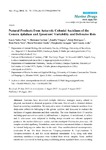Mostrar o rexistro simple do ítem
Natural Products from Antarctic Colonial Ascidians of the Genera Aplidium and Synoicum: Variability and Defensive Role
| dc.contributor.author | Núñez-Pons, Laura | |
| dc.contributor.author | Carbone, Marianna | |
| dc.contributor.author | Vázquez, Jennifer | |
| dc.contributor.author | Rodríguez, Jaime | |
| dc.contributor.author | Nieto, Rosa M. | |
| dc.contributor.author | Varela, María Mercedes | |
| dc.contributor.author | Gavagnin, Margherita | |
| dc.contributor.author | Ávila, Conxita | |
| dc.date.accessioned | 2017-09-26T08:24:06Z | |
| dc.date.available | 2017-09-26T08:24:06Z | |
| dc.date.issued | 2012 | |
| dc.identifier.citation | Marine Drugs 2012, Vol. 10, Pages 1741-1764 | |
| dc.identifier.issn | 1660-3397 | |
| dc.identifier.uri | http://hdl.handle.net/2183/19531 | |
| dc.description.abstract | Ascidians have developed multiple defensive strategies mostly related to physical, nutritional or chemical properties of the tunic. One of such is chemical defense based on secondary metabolites. We analyzed a series of colonial Antarctic ascidians from deep-water collections belonging to the genera Aplidium and Synoicum to evaluate the incidence of organic deterrents and their variability. The ether fractions from 15 samples including specimens of the species A. falklandicum, A. fuegiense, A. meridianum, A. millari and S. adareanum were subjected to feeding assays towards two relevant sympatric predators: the starfish Odontaster validus, and the amphipod Cheirimedon femoratus. All samples revealed repellency. Nonetheless, some colonies concentrated defensive chemicals in internal body-regions rather than in the tunic. Four ascidian-derived meroterpenoids, rossinones B and the three derivatives 2,3-epoxy-rossinone B, 3-epi-rossinone B, 5,6-epoxy-rossinone B, and the indole alkaloids meridianins A–G, along with other minoritary meridianin compounds were isolated from several samples. Some purified metabolites were tested in feeding assays exhibiting potent unpalatabilities, thus revealing their role in predation avoidance. Ascidian extracts and purified compound-fractions were further assessed in antibacterial tests against a marine Antarctic bacterium. Only the meridianins showed inhibition activity, demonstrating a multifunctional defensive role. According to their occurrence in nature and within our colonial specimens, the possible origin of both types of metabolites is discussed. | es_ES |
| dc.description.sponsorship | Ministerio de Ciencia e Innovación; CGL/2004-03356/ANT | es_ES |
| dc.description.sponsorship | Ministerio de Ciencia e Innovación; CGL2007-65453/ANT | es_ES |
| dc.description.sponsorship | Ministerio de Ciencia e Innovación; CGL2010-17415/ANT | es_ES |
| dc.description.sponsorship | Ministerio de Ciencia e Innovación; CTQ2008-04024/BQU | es_ES |
| dc.language.iso | eng | |
| dc.publisher | Molecular Diversity Preservation International | |
| dc.relation.uri | http://dx.doi.org/10.3390/md10081741 | es_ES |
| dc.rights | Reconocimiento 3.0 | es_ES |
| dc.rights.uri | http://creativecommons.org/licenses/by/3.0/ | |
| dc.subject | Antarctic colonial tunicates | es_ES |
| dc.subject | Deterrent activity | es_ES |
| dc.subject | Sea star odontaster validus | es_ES |
| dc.subject | Amphipod cheirimedon femoratus | es_ES |
| dc.subject | Antibacterial activity | es_ES |
| dc.title | Natural Products from Antarctic Colonial Ascidians of the Genera Aplidium and Synoicum: Variability and Defensive Role | |
| dc.type | info:eu-repo/semantics/article | |
| dc.rights.access | info:eu-repo/semantics/openAccess | |
| UDC.journalTitle | Marine Drugs | |
| UDC.volume | 10 | |
| UDC.issue | 8 | |
| UDC.startPage | 1741 | |
| UDC.endPage | 1764 |
Ficheiros no ítem
Este ítem aparece na(s) seguinte(s) colección(s)
-
GI- Quimolmat - Artigos [106]






